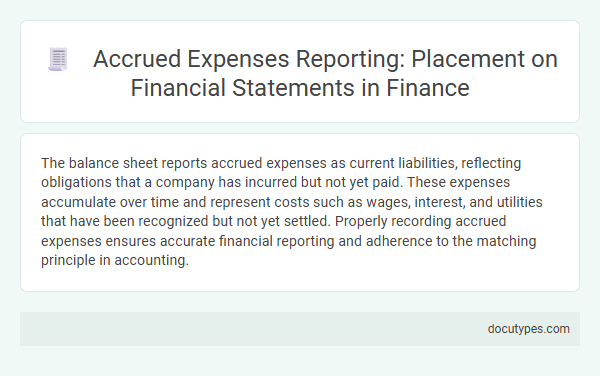The balance sheet reports accrued expenses as current liabilities, reflecting obligations that a company has incurred but not yet paid. These expenses accumulate over time and represent costs such as wages, interest, and utilities that have been recognized but not yet settled. Properly recording accrued expenses ensures accurate financial reporting and adherence to the matching principle in accounting.
Introduction to Accrued Expenses in Finance
Accrued expenses represent liabilities for goods or services that a company has received but not yet paid for by the end of an accounting period. These expenses are recorded to adhere to the matching principle in accounting, ensuring expenses are recognized when incurred rather than when paid. The balance sheet specifically reports accrued expenses as current liabilities, reflecting amounts owed that will require future cash outflows.
Definition and Types of Accrued Expenses
Accrued expenses represent liabilities for goods or services received but not yet paid by the end of an accounting period. These expenses are recorded to match revenues with the costs incurred during the same period.
- Balance Sheet - Reports accrued expenses under current liabilities as obligations payable within one year.
- Income Statement - Reflects accrued expenses as operating costs, reducing net income for the period.
- Cash Flow Statement - Shows adjustments for accrued expenses to reconcile net income to cash flows from operating activities.
Types of accrued expenses include wages payable, interest payable, and utilities payable, each representing unpaid costs that must be recognized in financial statements.
Importance of Accrued Expenses Reporting
The financial statement that reports accrued expenses is the balance sheet, specifically under current liabilities. Accrued expenses represent obligations for goods or services received but not yet paid by the reporting date.
Accurate reporting of accrued expenses is crucial for reflecting a company's true financial position and ensuring transparency. It helps stakeholders assess the company's short-term liabilities and cash flow management effectively.
Accrued Expenses on the Balance Sheet
Accrued expenses are reported on the balance sheet under current liabilities. These expenses represent obligations for goods or services that have been received but not yet paid. Properly accounting for accrued expenses ensures accurate financial reporting and reflects the company's true financial position.
Accrued Expenses in the Income Statement
Accrued expenses represent costs that a company has incurred but has not yet paid by the end of the accounting period. These expenses are recorded in the financial statements to accurately reflect the company's liabilities and operational costs.
You will find accrued expenses reported in the income statement as part of operating expenses, impacting the net income calculation. Properly accounting for accrued expenses ensures your financial reports provide a true picture of expenses incurred during the period, even if payment is pending.
Journal Entries for Accrued Expenses
The financial statement that reports accrued expenses is the balance sheet, under current liabilities. Accrued expenses represent obligations for expenses that have been incurred but not yet paid by the end of the accounting period.
Journal entries for accrued expenses involve debiting the appropriate expense account and crediting accrued expenses or accounts payable. This ensures your financial records reflect expenses in the period they occur, adhering to the matching principle. Properly recording accrued expenses maintains accurate financial statements for decision-making and compliance.
Recognition Criteria under Accounting Standards
| Financial Statement | Balance Sheet (or Statement of Financial Position) |
|---|---|
| Report Item | Accrued Expenses (also known as Accrued Liabilities) |
| Recognition Criteria |
Accrued expenses are recognized when a company incurs a liability for goods or services received but not yet paid for by the end of the reporting period.
According to IFRS (IAS 37) and US GAAP, recognition criteria include:
|
| Accounting Standards |
IFRS: International Accounting Standard (IAS) 37 - Provisions, Contingent Liabilities and Contingent Assets US GAAP: FASB ASC Topic 450 - Contingencies and various accrual guidance Both standards require recognition of accrued expenses when liabilities meet the above conditions. |
Impact of Accrued Expenses on Financial Ratios
Accrued expenses are reported on the balance sheet as current liabilities, reflecting obligations that have been incurred but not yet paid. These accrued liabilities affect key financial ratios by increasing current liabilities and impacting profitability measures.
- Balance Sheet - Accrued expenses appear under current liabilities, reducing the company's working capital and liquidity ratios.
- Income Statement - Accrued expenses increase operating expenses, lowering net income and affecting profitability ratios like return on assets (ROA).
- Cash Flow Statement - Accrued expenses do not directly affect cash flow until payment is made, influencing the reconciliation of net income to cash flows from operating activities.
Best Practices for Accrued Expenses Disclosure
Accrued expenses are reported on the balance sheet as current liabilities, reflecting costs incurred but not yet paid. Proper disclosure of accrued expenses ensures transparency and accuracy in financial reporting.
- Balance Sheet - Reports accrued expenses under current liabilities, showing obligations your company expects to settle soon.
- Income Statement - Reflects expenses incurred during the period, including those accrued, impacting net income.
- Notes to Financial Statements - Provides detailed disclosures on the nature, measurement, and timing of accrued expenses for clarity and completeness.
Which Financial Statement Reports Accrued Expenses? Infographic

